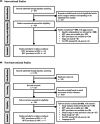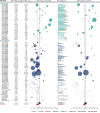A systematic literature review of the human papillomavirus prevalence in locally and regionally advanced and recurrent/metastatic head and neck cancers through the last decade: The "ALARM" study
- PMID: 38247106
- PMCID: PMC10905345
- DOI: 10.1002/cam4.6916
A systematic literature review of the human papillomavirus prevalence in locally and regionally advanced and recurrent/metastatic head and neck cancers through the last decade: The "ALARM" study
Abstract
Aims: The aim of this systematic literature review was to provide updated information on human papillomavirus (HPV) prevalence in locally and regionally advanced (LA) and recurrent/metastatic (RM) head and neck cancer (HNC) worldwide.
Methods: Electronic searches were conducted on clinicaltrials.gov, MEDLINE/PubMed, Embase, and ASCO/ESMO journals of congresses for interventional studies (IS; Phase I-III trials) as well as MEDLINE and Embase for non-interventional studies (NIS) of LA/RM HNC published between January 01, 2010 and December 31, 2020. Criteria for study selection included: availability of HPV prevalence data for LA/RM HNC patients, patient enrollment from January 01, 2010 onward, and oropharyngeal cancer (OPC) included among HNC types. HPV prevalence per study was calculated as proportion of HPV+ over total number of enrolled patients. For overall HPV prevalence across studies, mean of reported HPV prevalence rates across studies and pooled estimate (sum of all HPV+ patients over sum of all patients enrolled) were assessed.
Results: Eighty-one studies (62 IS; 19 NIS) were included, representing 9607 LA/RM HNC cases, with an overall mean (pooled) HPV prevalence of 32.6% (25.1%). HPV prevalence was 44.7% (44.0%) in LA and 24.3% (18.6%) in RM. Among 2714 LA/RM OPC patients from 52 studies with available data, mean (pooled) value was 55.8% (50.7%). The majority of data were derived from Northern America and Europe, with overall HPV prevalence of 46.0% (42.1%) and 24.7% (25.3%) across studies conducted exclusively in these geographic regions, respectively (Northern Europe: 31.9% [63.1%]). A "p16-based" assay was the most frequently reported HPV detection methodology (58.0%).
Conclusion: Over the last decade, at least one quarter of LA/RM HNC and half of OPC cases studied in IS and NIS were HPV+. This alarming burden is consistent with a potential implication of HPV in the pathogenesis of at least a subgroup of HNC, underscoring the relevance of HPV testing and prophylaxis to HNC prevention and management.
Keywords: cancer prevention; cancer risk factors; epidemiology and prevention; head and neck cancer; viral oncology.
© 2024 The Authors. Cancer Medicine published by John Wiley & Sons Ltd.
Conflict of interest statement
Figures



References
Publication types
MeSH terms
Grants and funding
LinkOut - more resources
Full Text Sources
Medical

